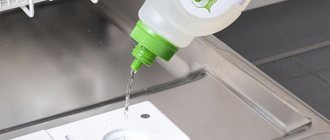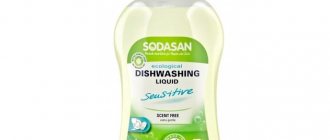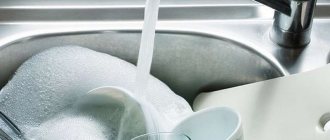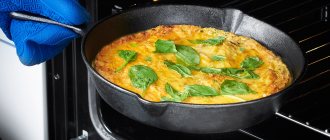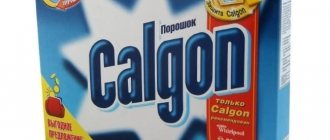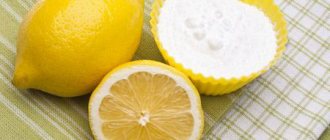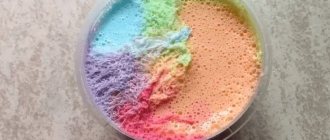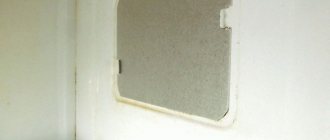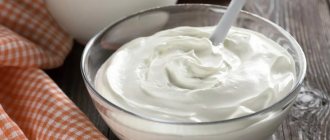Washing dishes is a job that has to be done every day. To facilitate the process, manufacturers present dozens of brands on the market competing for leadership. It is important to find among them the most effective dishwashing detergent that is harmless to health. The issue of quality is especially important if the family has children or people suffering from allergic diseases. In such cases, many return to the use of traditional methods - less effective, but guaranteed safe for health.
What are dishwashing gels made of?
Composition of dishwashing gel:
- Surfactants, alkali, betaine, enzyme, citric acid, sodium laureth sulfate - for washing off fat
- Urea, hydrotope, benzothiazolyl - for accelerated washing of grease and other contaminants
- Cocamide, sodium chloride and other thickeners - for the viscous state of the gel
- Antibacterial agents – to fight germs
- Stabilizers – for foaming
- Glycerin, phenoxyethanol, aloe vera extract or other medicinal herbs - to soften the skin of the hands
- Flavorings – for a pleasant smell
- Dyes - to give the desired color
- Preservatives – for longer storage
- Salts of peroxide acids - for whitening
- Oxygen bleach (if it is included, this is a good product)
Particularly hazardous substances in dishwashing gels:
- Limonene, hexylcinnamaldehydes are allergens that can trigger asthma
- Diethanolamine is dangerous, especially for the liver
- Katon, phenoxyethanol – preservatives
- Chlorine
- Phosphates (potassium orthophosphate, sodium hydrogenphosphate) or phosphonates
- Triclosan
- Phthalates
Composition of dishwashing gels
Compound
Almost the same compositions are used for all cleaning products. The base for them is taken from a mixture of components such as:
- surfactant;
- Acids;
- Anionic substances.
Surfactants - active substances on the surface layer provide the very foam that supposedly “takes” dirt and grease from the plates well. They also promote water tension and lead to the dispersion of dirt. But there is an opinion that foam has nothing to do with cleanliness. In the composition, together with other components, foaming indicates the quality of the product, and only thanks to certain compounds, even the dirtiest dishes can be cleaned.
| Types of surfactants | Decay | Impact |
| As a result of electrical dissociation, such components form negative ions - anions. | The molecules of persistent contaminants are positively affected, destroying the internal structure. |
| Cations are obtained as a result of the breakdown of positive surfactant particles. | Cations, giving a charge to destroy greasy stains, easily remove them from the surface of the plates, but are not completely washed off, since part of the positive charge remains inside the molecules of the product. |
| Nonionic surfactants are not subject to decomposition. | They do not affect the strong dirt molecule in any way, but are also washed off the surface easily and quickly, ensuring easy destruction of the structural layer of fat. |
Advice: Since the nature of the contaminants on each plate is different, manufacturers add surfactants of different nature to the composition in order to comprehensively combat heavy and light contaminants. Otherwise, you would have to buy several products - one for grease, another for simple washing, and a third for stubborn stains.
Testing
To understand how the main component of the fight against dirt behaves, we decided to test all the detergents, identifying the behavior of the particles during exposure to the dirty layer on the dishes. During the research, a test was also carried out that helped identify the most active surfactant particles.
Sulfonic acid salts
Acid sulfoesters
Alkylsulfonates
Alkylaryl sulfonates
Alkyl sulfates
Sulfonated fats
Sulphated oils
Fatty acid
It also turned out that the fairy dishwashing detergent, which is so popular, contains polyethylene glycol ethers. Depending on the type of cleaning products, their quantity varies. There are also nonionic additives of new generations - polyalkyl glycosides, which have a lower degree of toxicity, are washed off faster, and are easier to deal with greasy stains. They “take care” of the skin of your hands, preventing it from drying out. The price of such products is much higher due to modern production technologies, but consumption requires more time to use up the entire bottle.
Previously, we talked about additional components, and below we present a photo and a list with the names that are included in some of the products:
Enzymes and Enzymes
Antiresorbents
Salts of neutral acids
Emollients
Fragrances
Dyes
Preservatives
Foam stabilizers
They are needed for the decomposition of polysaccharides, proteins and fatty oils. Without this, the action of not a single most powerful surfactant component is possible, no matter how new in production in the world of technology it may be. To enhance all the resulting mixtures, other molecules are added in the smallest doses:
- Carbonates;
- Sodium chlorides;
- Phosphates;
- Sodium polyphosphates;
- Sodium citrates;
- Zeolites;
- Perborates;
- Di- or trichloroisocyanurates.
They are also needed to remove residues of coffee, tea, fructose, dyes and natural color stains. Their auxiliary function is to disinfect dishes. Sometimes, the same frosh dishwashing detergent may contain bleaches, reagents for the decomposition of sodium silicates. They can act as corrosion inhibitors when you clean hard metal utensils. Other series of this product can be used for the dishwasher; and it will not suffer from scale thanks to the compatible sodium molecules.
Ability
Since many products are endowed with such a “rich” composition that it’s a shame to wonder what ability they have for simple dishwashing? Surely, you thought, if 1-2 components are needed by nature to fight fat, why all these enhancers and other additives? Let's look at this question using dishwashing powder as an example. It has a good analogue - Amway dishwashing detergent, which has established itself as a herbal and natural set of the best herbs and products for removing grease and dirt. It will be written on the packaging that there is a surfactant, without specifying the area of extraction or production, additional components that are not mentioned, etc.
Therefore, it’s time to find out why the cost of natural products, as manufacturers claim, is higher, and how they differ in reality. Their ability to destroy fat deposits is the same, but differences are still present.
Trilon B
The substance is necessary to soften water, and thanks to it, the products seem natural, because it is the plant components that can protect the skin from chemicals. Trilon B increases the ability of the entire product to interact with dirt, and without it, no surfactants make sense.
Carboxymethylcellulose
Repeated deposition of fats over a long period of time and the absence of organic components are all the merit of this substance. Any dirt that comes into contact with the detergent may remain on the surface of the dishes again, but this is not possible, and all the grease is washed off with water, keeping the dirt particles inside the molecules.
Hydrotropes
Cumene and xylene sulfonate, urea and lower grade alcohols - they all increase and enhance the degree of solubility of surfactants in water. For example, have you noticed that myth dishwashing detergent takes a long time to dissipate and is difficult to remove from the surface? It does not contain these “good” molecules, but even without them it removes fat quite well. Considered more natural, but difficult to obtain in some small towns.
Amylase
They, together with proteases and lipases, and other enzymes, effectively remove protein contaminants that cannot be excreted and dissolved in water. The proof will be in Mama dish detergent, which is recommended for washing children's plates and cast iron pans.
Stabilizers
We talked about them above, but in some imported products there are more of them than required by domestic GOST. The cleaning product foams well, the foam does not clump, is not washed off and can remain in the sink for a long time without water. This is the merit of alkylamides.
Silicone
Just like glycerin, allatoin and plant extracts, it has a good effect on the skin of the hands. More precisely, it prevents chemical compounds from settling on the skin, causing allergies. If there are a lot of them in the composition, gloves for washing dishes will not be needed; but not all manufacturers indicate the exact amount of their presence.
Milk and aloe vera
As part of the detergent, it provides a protective film for hands and intensive evaporation of harmful moisture vapors; At the same time, it protects the dishes from the re-application of dirt. Milk molecules are often found in the cosmetics industry to protect hands from cold and wind.
Also, detergency can be determined by the presence of active hydrogen ions pH. The indicator will tell you whether your product is harmful or neutral. Perhaps this is one of the main tasks for today, which will allow us to lift the curtain on the mysterious composition of the product. The pH value indicates an alkaline or acidic environment, and the stronger it is, the more dangerous your hands are.
Important! According to the requirements of GOST standards, regarding the production of household chemicals, pH values can vary from 4.0 to 11.5. Neutral value – 6.0 – 7.0; which indicates the possibility of using such a detergent every day. The optimal product will be one that has a mark of 5.5 - this is a physiological composition for the skin that will never harm it.
Washability
The washability indicator is very important, as is the composition of the product itself. Let's say you use dishwashing gel, but you are not satisfied with the formation of foam, the result of washing, and the residue of the product is not always a pleasant thing. It is difficult to wash off, so many people switch to the liquid type of components in a bottle. Drop dish detergent is claimed to be the safest and “long-lasting” detergent compared to similar products. A drop of the product and you will wash an entire mountain of dishes, which means it must be difficult to wash off, since so little is needed for a large amount of work.
However, this indicator speaks of something else - the ability of the product to be washed off with water along with dirt, and not of a pure product. Surfactants are difficult to wash off by their nature, and to ensure a completely glossy surface, you need to add some impurities so that everything is removed without leaving a residue.
| Surfactant type | Washability index |
| According to GOST, the indicator limits are set at 0.1 mg/dm3. |
| No more than 0.5 mg/dm3 according to global standards, since domestic manufacturers rarely use anionic types of surfactants. |
| Neutral | Up to 0.01 mg/dm3, which are contained in children's products, and up to 0.05 mg/dm3 for adults. |
Advice: For washing children's dishes, it is better to choose those bottles that are clearly written on them - surfactants of neutral or plant origin. They do not enter the child’s body with food and are easily removed from the surface.
How to determine how harmful a dishwashing gel is?
The main component in dishwashing gel is a surfactant, or surfactant for short . All products containing this substance are divided into 4 groups:
- Anionic surfactants (also called A-surfactants or A-tensides) - best cope with pollution, are cheap, but also the most harmful. Gels with anionic surfactants dry out the skin of the hands, get inside us from our plates and harm the heart, blood vessels, liver, kidneys, and lungs.
- Cationic surfactants wash greasy dishes worse, but are not as toxic as anionic ones.
- Ampholytic or amphoteric surfactants act differently: in an alkaline environment as anionic surfactants, in an acidic environment as cationic ones.
- Nonionic or nonionic surfactants are the safest for humans and nature; they decompose into water and carbon dioxide.
If the company producing the detergent adheres to the standards, then the surfactant should be no more than 5%.
Attention. There are also harmless washing gels that contain surfactants from plants, they are called saponins (soap nut, soap root, cherimoya extract). Such means have the following symbols:
- Ecogarantie
- Eco Label
- QAI
The most effective dishwashing gels also turn out to be the most harmful
Popular manufacturers
The popularity of a product is often influenced by advertising rather than its actual characteristics. Thus, Fairy products have held the leadership in this area for many years, although studies show that they are more chemically aggressive and more expensive than many other drugs. However, they are used by more than a third of consumers in our country.
Other brands that have gained popularity as potent drugs:
- AOS “Lemon” is the most economical product, actively produces foam, is effective in cold water, and removes old stains. Disadvantages: dries the skin, can cause allergies, contains chemical fragrances and preservatives.
- Sorti “Lemon” is an inexpensive domestic analogue of Fairy. Removes fats of any origin and other types of contaminants even in low temperature water. It degreases plastic well and does not leave streaks on glass. The disadvantages are that the consistency is too liquid, that is, uneconomical, and the high concentration of synthetic components.
- Myth - the gel is economical, inexpensive and effective. Doesn't dry out the skin of your hands and has a pleasant smell. Its advantages are due to its disadvantages - the combination of low cost and high efficiency is achieved by using aggressive chemical ingredients.
Health-safe balms include harmless, biodegradable organic ingredients. You can use these products to wash food, and you can even use the leftovers to water your home flowers. Popular formulations:
- Mama Ultimate is a Japanese product containing soda. It efficiently cleans pots and plates in cold water and has a softening effect on the skin of the hands.
- Zero with mustard and honey extract is an eco-gel based on citric acid and table salt from a domestic manufacturer. It does not contain chemicals, and therefore is suitable for washing children's hygiene products, toys, and dishes.
- Synergetic (Germany) - due to its complete washability, it is suitable for washing vegetables, fruits and other food products, children's dishes, toys. Not dangerous if swallowed. The product is completely biodegradable, washes away grease and dirt even in ice water.
The only common disadvantage of all the natural dishwashing detergents listed above is their high cost for domestic buyers.
Hypoallergenic balms are not as expensive as environmentally friendly products, but will protect allergy sufferers and children from exposure to many compounds that are harmful to health. These include detergents BioMio (Russia), Sodasan Sensitive (Germany), Lion Charmy Magic (Japan), which can even be found in a pharmacy, LV (Finland), AmWay Dish Drops (USA). In the line of such products, you can choose an unscented option.
As you can see, the volume of supply on the market for dishwashing preparations is large. You can find a product to suit every taste and budget. The main thing is to consider not only the effectiveness of the product, but also its impact on health, as well as its safety for the environment.
AOS "Lemon"
Mama Ultimate
Sorti "Lemon"
Synergetic
Zero
Myth
How do dishwashing gels affect humans and nature?
Although it is written on the dishwashing gel that it does not harm the skin of the hands, after using it the following consequences may occur :
- Allergic reaction on the skin of the hands and throughout the body
- Headache
- Fatigue
- Breathe heavily
- Development of skin disease – dermatitis
- Residue of detergent from dishes can enter the human body, accumulate there, and lead to intoxication
- Vapors from detergent cause ailments associated with the lungs and bronchi, manifested by a dry cough
- Constant inhalation of vapors or small amounts of substances from dishes, even relatively harmless detergents, leads to decreased immunity
- Detergents containing phosphates, when released into the environment, harm water bodies - they cause water blooms (covered with algae)
With prolonged use of dishwashing gels, they can cause harm to humans: allergies and skin diseases, inflammatory diseases of the lungs and bronchi
Varieties
Depending on the consistency of dishwashing detergents, there are:
- liquid (gels, concentrates, balms);
- powdered and in the form of pastes.
Gels are valued for their economy (a few drops foam generously), convenience, and effectiveness in cold water. Can be regular or concentrated. The latter are economical to use, since they require dilution with water for use (according to the instructions on the package). The downside of gels is poor rinsing. Few housewives know that after cleaning dishes, they should be rinsed with a large amount of water (up to 50 liters per plate). A thin layer of toxic substances usually remains on its surface, then entering the body with food.
A variety of gel forms are balms. These are preparations to which substances have been added that care for the skin of the hands and have a moisturizing effect on it. The action of powders and pastes is based on the content of abrasives (silicon dioxide, aluminum oxide, finely ground pumice). They remove complex stains well; they can be used to clean sinks and stove surfaces, but such preparations do not wash away grease well in cold water.
What can replace store-bought dishwashing gels?
Store-bought dishwashing gels are harmful to the skin of your hands and stomach. They can be replaced with household products that are less harmful to the skin of the hands and safe (with the exception of soda ash) for internal organs:
- Regular vinegar - along with other household substances, removes grease and disinfects dishes
- Laundry soap - it is made from organic substances, disinfects, softens water
- Baking soda – disinfects, cleans and removes grease
- Soda ash is more caustic than baking soda, but it also softens water better, disinfects, and removes old stains and grease.
- Dry mustard - washes away grease well
- Ammonia solution is added to homemade gel to better wash away grease stains
- Rock salt is good for cleaning old greasy stains without scratching dishes.
- Hydrogen peroxide - removes fat
From these ordinary powders, liquids and solutions, you can prepare homemade cleaning gels for washing dirty dishes, stoves, tiles, bathtubs and other items in the house.
Ordinary household products that we use every day can replace store-bought dishwashing gels
How do homemade dishwashing gels affect humans, nature, their advantages and disadvantages?
Homemade dishwashing gels have a number of advantages over store-bought ones:
- Not harmful to the environment, human and animal health
- Less harmful to the skin of the hands
- Does not contain strong allergens
- Almost harmless to the stomach, intestines, lungs and other organs
- Homemade detergent will be cheaper in cost than good quality store-bought detergent
- A homemade remedy washes off dishes more easily than a store-bought one.
- The home remedy can have any scent you like, because you can add your favorite essential oil to it
Disadvantages of homemade dishwashing gels:
- Doesn't wash greasy dishes as well as store-bought detergent
- You need much more homemade cleaning gel than store-bought
Mustard, soda, laundry soap, from which you can make homemade dishwashing gels, do not harm the environment around us
How to prepare homemade cleaning gels for dishes and other household needs?
The following homemade cleaning gels are universal because they can be used to clean:
- Dishes
- Hob surface
- Tiles on the wall and floor
- Sink
- Yellowish stains in the bathroom
Attention. If the stove or dishes are very dirty, you should deal with them as follows: rub with homemade cleaning gel and leave for 10-15 minutes, and then rinse.
Universal home cleaning gel for dishes and kitchen utensils: recipe
For the washing gel we take:
- 0.5 pieces of laundry soap
- 1 liter of water
- 4 tbsp. l. ammonia solution
- 3 tbsp. l. mustard powder and baking soda
Cooking:
- Grate half a bar of soap onto a fine grater.
- We take an old pan or an old bucket that we don’t mind, and heat the water until it’s hot.
- Pour grated soap into the water, heat until the soap dissolves, then remove from heat and let cool.
- When the liquid soap has cooled, add mustard powder and baking soda to it and mix.
- Open the window and pour the ammonia solution into the mixture, mix quickly, pour into glass jars, close with plastic lids and let it brew for 2-3 hours, and you can use it.
Ingredients for homemade cleaning gel for dishes, baths, washbasins
Quick homemade washing gel for dishes, baths from laundry soap and soda: recipe
In the washing gel we will take:
- 0.5 pieces of soap (laundry)
- 50 g soda (baking soda)
- 1 glass of water
- 10 drops of lavender, lemon or pine oil (essential)
Cooking:
- Grate the soap, preferably a fine one, and pour it into boiling water, stir until the soap dissolves. Remove from heat, let cool slightly and add baking soda and stir.
- Add perfumed oil to the soap-soda mixture, stir, when it cools down, you can use it.
If you don’t have much time, you can quickly prepare a soda-soap dishwashing gel with the addition of your favorite essential oil
How to make homemade dishwashing gels?
Soap-glycerin homemade dishwashing gel: recipe
This washing gel not only washes dishes, but also softens the skin on your hands.
For the washing gel we take:
- 2 tbsp. l. grated laundry soap
- 1 liter of water
- 8 tbsp. l. glycerin
Cooking:
- Stir the finely grated soap in hot water, heating it on the stove until dissolved.
- When the liquid soap has cooled, pour glycerin into it, mix, pour into a plastic jar and you can wash the dishes.
Ingredients for soap-glycerin dishwashing gel
Effervescent homemade washing gel for greasy dishes: recipe
For the gel we take:
- 2 tbsp. l. baking soda and citric acid powder, you can use hydrogen peroxide or vinegar instead of acid
- 170 ml warm water
Cooking:
- Stir the baking soda in hot water, add hydrogen peroxide or vinegar, shake, pour into a bottle with a lid and use immediately.
Attention. We use effervescent washing gel like this: spread the gel on greasy dishes with a sponge, leave for 3-5 minutes, and rinse with warm water.
Soap-lemon homemade dishwashing gel: recipe
This product washes greasy dishes well and is completely harmless to nature and animals.
For the gel we take:
- Half a piece of grated laundry soap
- 1 liter of water
- 25 ml glycerin
- 1 tbsp. l. citric acid powder or juice from half a fresh lemon
- 1 tsp. alcoholic drink or vodka
Cooking:
- Pour boiling water over the soap shavings and stir on the stove until dissolved.
- Remove from heat, let cool slightly, add citric acid powder or squeeze juice from half a lemon, glycerin, mix and you can wash the dishes.
Hand-friendly soap-lemon dishwashing gel
Homemade mustard dishwashing gel: recipe
This washing gel cleans heavily soiled dishes well.
Let's take in the gel:
- 2 tbsp. l. mustard powder
- 1 liter of water
Cooking:
- Pour mustard powder into hot water, stir everything, and the gel is ready - you can wash dirty dishes.
Attention. If you add 1-2 tbsp to the mustard washing gel. l. baking soda, then this paste can wash even old greasy stains on pans.
So, we figured out how harmful store-bought dishwashing gels are and what can be used to replace them.
Requirements
The list of properties inherent in a good dishwasher varies depending on the purpose and nature of its use. For example, foaming gel-like preparations are suitable for lightly soiled cups and glasses, but for heavily soiled ones it is better to use powders. However, there are certain criteria for a good dish detergent. It should be:
- effective - break down fats, remove stubborn plaque, old stains even in cold water;
- safe - do not remain on kitchen utensils after rinsing them, rinse off easily;
- hypoallergenic - do not cause irritation to the hands, mucous surface of the nasopharynx, do not dry out the skin;
- environmentally friendly - containing no or as little synthetic fragrances as possible;
- universal - suitable for washing not only dishes, but also other kitchen surfaces;
- economical (abundantly foaming) and budget-friendly in cost.
The most attractive products for consumers are products that are conveniently packaged, have a pleasant smell, and contain added substances that soften the skin of the hands. Not all of the listed characteristics “get along” with each other, such as the ability to wash away any contaminants in cold water, environmental friendliness and low cost. When purchasing, you have to make a choice which factor is more important.
After washing, dishes must be rinsed thoroughly
Dishwashing detergent should be selected taking into account the degree of soiling
Video: Dishwashing detergent - harm and expert reviews
We recommend reading:
- 20 tips for order and cleanliness
- What should a man do when he comes home?
- Mold, fungus on wooden, plastic windows, slopes: reasons, how to remove
- How to beautifully and modernly decorate a window in a house, apartment, or country house
- How to properly dry different things in an apartment after washing
- All-round cleaning is simple, fast and the house is always perfectly clean
